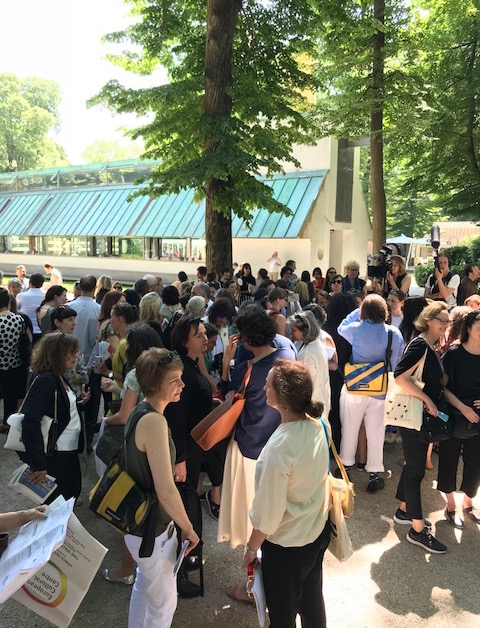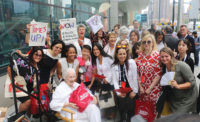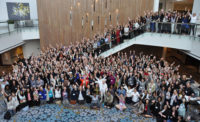In the weeks leading up to the 2018 AIA Conference on Architecture, Frances Halsband, FAIA, of Kliment Halsband Architects in New York, has been building support for a formal action to address discrimination, harassment, and abuse within the profession. Memorial Day weekend, the architect sent a statement called Fellowship Is Leadership to some 60 contacts in the College of Fellows. More than 350 Fellows—including Denise Scott Brown, Julie Snow and César Pelli—affirmed their support of that document, with several sharing stories of how discrimination in the industry had affected them or loved ones.
To formalize that support, the petition has been formatted according to AIA bylaws into what Halsband intends to be an “actionable, legal, and accurate” resolution to update the AIA Code of Ethics and Professional Conduct. As of Wednesday, more than 200 AIA members have already signed the document, either electronically or at last night’s annual meeting of the New York chapter of the AIA—surpassing the 50 signatures necessary for the resolution to be heard on the floor of the Business Meeting at the 2018 national conference, taking place next week in New York.
The resolution calls out “ethical misconduct at the highest levels of [the] profession” and a system where “people of diverse backgrounds and identities enter the profession with high hopes, only to leave in disillusionment when they encounter unfair pay practices, lack of respect, abuse, or harassment,” while also demanding “swifter, decisive, and public action” for those who discriminate against others.
This latest effort comes nearly a decade after the first AIA Women’s Leadership Summit, and directly on the heels of allegations of sexual harassment by prominent men in the industry that were levied in the first half of this year. But Halsband’s own turning point came when listening to female architecture students at Yale and their passionate views about wanting to admire whole people and not just their work. “That was the moment I said, ‘Wait a minute, somebody has got to do something,’” she recalls.

In developing her message, Halsband reached out to leaders in the growing movement of equity advocacy in architecture—including Rosa Sheng, FAIA, of Equity by Design (see her curated guide to the AIA Conference here) and Harvard’s Toshiko Mori, FAIA, who was among the prominent female architects who staged a flash mob demonstration at the Venice Architecture Biennale last month. Through these conversations, Halsband’s message has taken a more intersectional approach that encompasses all people in the industry.
“I think part of this frustration and these new resolutions is that things aren't happening fast enough,” says Sheng, principal and director of equity, diversity and inclusion at SmithGroupJJR. In 2015, she brought forward a resolution to make the ideals her current job title enumerates become priorities within the AIA, which led to the creation of a committee to devise strategies to change the culture. “It's a solution that has to happen from both sides. Institutional change, cultural change does take a while, but it's more permanent in its effects. But then in the immediacy, there's activism, there's a grassroots demand for change.”
It’s a feeling that resonates with other leaders in the industry as well. “There are different moments in time when you realize you have to state your values a little louder a little bit more thoughtfully or collectively or put them in writing,” says Carole Wedge, FAIA, of Shepley Bulfinch, who signed the initial statement.
This Monday, the AIA sent an email to the College of Fellows (COF) highlighting the Institute’s recent “activities to combat sexual harassment in the profession,” signed by 2018 AIA President Carl Elefante, FAIA, and 2018 COF Chancellor Raymond G. Post, Jr., FAIA. The email, which did not directly address the resolution, highlighted recent developments, such as a Model Harassment Policy, as well as two sessions on sexual harassment at convention. Elefante says the message was the second in a series of updates shared with AIA leadership to make sure “the discourse [is] based on the facts of the matter.”
But while Halsband’s petition claims not enough has been done, Elefante is quick to cite a number of ongoing initiatives, including a review of the current Code of Ethics by the National Ethics Council, which will present its recommendations in September. “I think that we are doing this with all due diligence and also due haste; being deliberate also matters. We want to establish changes that are laying the foundation for a culture change,” Elefante says. He points out that beyond the new wave of awareness of discrimination in the workplace, the field of architecture is also contending with a massive generational shift— Millennials will replace some 20,000 Baby Boomers within the industry in coming decade—at the same time the world is entering a process of mass urbanization. “I believe it's a threshold moment for the architectural profession, and it's not just in this regard,” Elefante says, referring to diversity and inclusion. And that, he says, will require dramatic shifts of thinking in the industry at large.
“I applaud all of that,” Halsband says of the efforts described in the AIA email. “But that’s a little different than just saying, ‘We’re coming out with a statement of where we stand.’ I’m not seeing quite that. I think there’s still work to do. The hundreds of people who have signed on all believe there’s still work to do.”
Like many evolved in the discussion, Halsband sees today’s challenges as issues that architects are uniquely suited to address. “We imagine that our buildings are actually contributing to a better civic and cultural life...we think we have a higher purpose,” Halsband says. “So who better than architects?”





Post a comment to this article
Report Abusive Comment